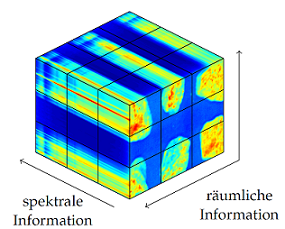Material classification in optical inspection systems using hyperspectral data
- contact:
- project group:
Image Processing
Material classification in inspection systems and sorting plants is an integral part of the process chain in many areas of the economy. It allows to distinguish between different materials and to measure material compositions. This is used, for example, in the food industry for the detection of foreign materials, in mining for the enrichment of ores and in recycling for the separation according to material classes.
With the help of different methods of image processing, bulk material to be sorted is classified and the result is passed on to a mostly pneumatic sorting device. In many cases a greyscale or RGB line scan camera is used for this purpose. For demanding sorting tasks, the visible spectral range is often not sufficient and the sensor system must be supplemented by cameras that are also sensitive in the near infrared range.
In this project a systematic procedure for the selection of an optical camera system for material classification is investigated. For this purpose, hyperspectral images, which contain an optical spectrum for each pixel, are used to evaluate the separability of different materials. In addition, a novel procedure is investigated which allows the use of hyperspectral cameras for spectral segregation in inspection systems by fusion of several cameras.
In a first application scenario, the hyperspectral camera is used in the laboratory to support the design of an inspection system with the extensive information gained with it, thus enabling the best possible problem-adapted solution. Instead of a hyperspectral camera, multispectral sensors are to be used in the inspection system, which meet the requirements for real-time classification.
The key question here is which multispectral sensors should be used or which spectral ranges should be extracted by optical filters in order to achieve a satisfactory classification for a specific classification problem.
In addition to good separability, high robustness against changes in the image signal is required. These changes can be caused, for example, by incorrect calibration, contamination or wear and tear. Taking these influences into account already when selecting optical filters enables satisfactory classification results to be achieved even if the signal changes.
In a second scenario under consideration, hyperspectral cameras are used in inspection systems despite their disadvantages in terms of resolution and speed. The information, which is missing due to the lower spatial resolution of the hyperspectral sensor, is to be obtained by additional multispectral or panchromatic sensors with lower spectral, but higher spatial resolution. This should enable the use of methods for material classification such as spectral segregation.
If you are interested in student theses (bachelor and master theses) please contact Wolfgang Krippner. You should have the following skills:
- Very good knowledge of signal processing
- Interest in classification/pattern recognition, machine learning, data mining and image processing
- Very good knowledge of C++ and/or Matlab is required

